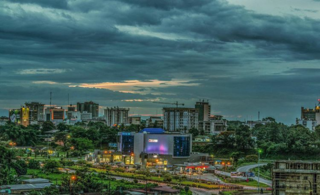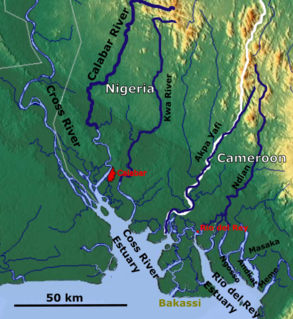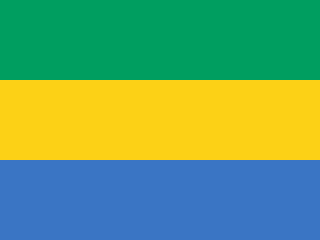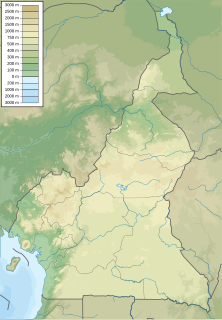
The Isubu are an ethnic group who inhabit part of the coast of Cameroon. Along with other coastal peoples, they belong to Cameroon's Sawa ethnic groups. They were one of the earliest Cameroonian peoples to make contact with Europeans, and over two centuries, they became influential traders and middlemen. Under the kings William I of Bimbia and Young King William, the Isubu formed a state called Bimbia.
A jengu is a water spirit in the traditional beliefs of the Sawa ethnic groups of Cameroon, particularly the Duala, Bakweri, and related Sawa peoples. Among the Bakweri, the name is liengu. Miengu are similar to Mami Wata spirits.
The Mulimba are an ethnic group of the Republic of Cameroon. They belong to the Sawa peoples, those of the Cameroonian coast.
Ewale a Mbedi was the eponymous ancestor of the Duala people of Cameroon. According to the oral histories of the Duala and related Sawa peoples of the Cameroon coast, Ewale hailed from a place called Piti. He and his followers migrated southwest to the coast and settled at the present-day location of Douala. The area was inhabited by the Bassa and/or Bakoko, who were driven inland by the new arrivals. Meanwhile, Ewale and his followers set up trade with European merchant ships.
Mbedi a Mbongo is the common ancestor of many of the Sawa coastal ethnic groups of Cameroon according to their oral traditions. Stories say that he lived at a place called Piti, northeast of present-day Douala. From there, his sons migrated south toward the coast in what are known as the Mbedine events. These movements may be mythical in many cases, but anthropologists and historians accept the plausibility of a migration of some Sawa ancestors to the coast during the 16th century.
Mbongo is the common ancestor of the Sawa peoples of Cameroon according to their oral traditions. Sawa genealogies usually place Mbongo at the head of the lineage. Mbongo's son, usually given as Mbedi a Mbongo, lived at Piti on the Dibamba River. From there, Mbongo's grandsons migrated south toward the coast to found the various Sawa ethnic groups. Some stories make these migrants Mbongo's sons rather than grandsons.
George or Joss, born Doo a Makongo or Doo a Mukonga, was a king of the Duala people in the late 18th century. Doo a Makongo was the son of Makongo a Njo. He lived at Douala on the Wouri estuary on the coast of Cameroon. By 1788–1790, Doo was a powerful ruler in the area. During this time, the British slave trade was at its height, and Douala was the primary trading post in the region.
Kwane a Ngie, known in British records as Angua or Quan, was a Duala ruler from the Bonambela sublineage who flourished from 1788 to 1790 in Douala, Cameroon. The British slave trade was at its height at this time, and, although a rival ruler from the Bonanjo sublineage named George or Joss reigned simultaneously, British records point to Kwane as the more powerful or respected leader.
Priso a Doo, also known as Preshaw, Preese, and possibly Peter, was a Duala ruler who lived on the Wouri River of the Cameroons in the late 18th century. His violent behaviour lost him his birthright and catalysed the split of the Duala people into rival Bell and Akwa sublineages.
Elame a Doo was a ruler of the Bonapriso sublineage of the Duala people who lived on the Wouri estuary of Cameroon in the late 19th century. He was the son of Doo a Priso and the grandson of Priso a Doo. Elame signed the 1884 German-Duala treaty that granted the German Empire sovereignty over Cameroon.
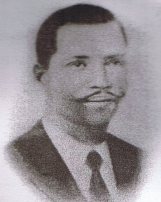
Rudolf Duala Manga Bell was a Duala king and resistance leader in the German colony of Kamerun (Cameroon). After being educated in both Kamerun and Europe, he succeeded his father Manga Ndumbe Bell on 2 September 1908, styling himself after European rulers, and generally supporting the colonial German authorities. He was quite wealthy and educated, although his father left him a substantial debt.
Ewonde a Kwane was a Duala ruler of the Bonambela/Akwa lineage who lived in Douala on the Wouri River. Ewonde was the son of the powerful chief Kwane a Ngie. Ewonde died early, causing a secession crisis in Bonambela. Ngando a Kwa claimed to be his heir and declared himself equal to Bele a Doo, leader of the Bonanjo/Bell lineage. Ewonde's daughter Kanya married Enjobe, an Aboh slave or immigrant in Douala. Their son would found the Bonambele/Deido sublineage. Duala tradition states that another of Ewonde's daughters, Lesenge, married into Isubu royalty and was the mother of King William of Bimbia.
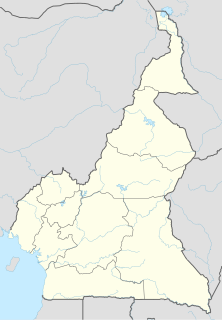
Mundame or Moundamé is a community in Cameroon, in the Southwest Region, about 2 kilometres (1.2 mi) from the Mungo River. The river is navigable south of Mundame for about 100 kilometres (62 mi) as it flows through the coastal plain before entering mangrove swamps, where it splits into numerous small channels that empty into the Cameroon estuary complex.
Auguste Manga Ndumbe Bell was a leader of the Duala people of southern Cameroon from 1897 to 1908 during the period after the German colonialists assumed control of the region as the Kamerun colony.

Ndumbé Lobé Bell or King Bell was a leader of the Duala people in Southern Cameroon during the period when the Germans established their colony of Kamerun. He was an astute politician and a highly successful businessman.

Jantzen & Thormählen was a German firm based on Hamburg that was established to exploit the resources of Cameroon. The firm's commercial and political influence was a major factor in the establishment of the colony of Kamerun in 1884.
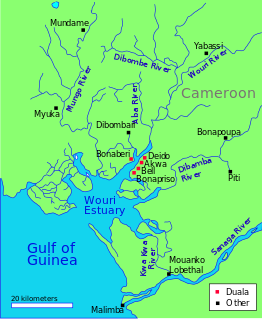
The Wouri estuary, or Cameroon estuary is a large tidal estuary in Cameroon where several rivers come together, emptying into the Bight of Biafra. Douala, the largest city in Cameroon, is at the mouth of the Wouri River where it enters the estuary. The estuary contains extensive mangrove forests, which are being damaged by pollution and population pressures.



